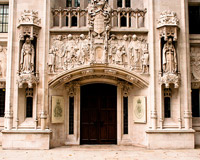 The Supreme Court today gave its third judgment in the long-running dispute between the owners and operators of a Suffolk motorsports stadium and a couple that bought a nearby property and complained of noise nuisance, this time upholding a conditional fee arrangements costs regime that will see the losing party liable for hundreds of thousands of pounds in legal bills.
The Supreme Court today gave its third judgment in the long-running dispute between the owners and operators of a Suffolk motorsports stadium and a couple that bought a nearby property and complained of noise nuisance, this time upholding a conditional fee arrangements costs regime that will see the losing party liable for hundreds of thousands of pounds in legal bills.
By a 5-2 majority, the Court rejected a claim that the costs regime introduced by the Access to Justice Act 1999 infringed Article 6 of the European Convention on Human Rights and/or Article 1 of the First Protocol to the Convention.
Though the 1999 Act regime has now been repealed and replaced by the provisions of Part 2 of the Legal Aid, Sentencing and Punishment of Offenders Act 2012, it will continue to apply in a number of pending actions.
Katherine Lawrence and Raymond Shields – whose home at Fenland, Cooks Drove, West Row, near Mildenhall, is just 560 metres from the West Row stadium, home of the successful Fen Tigers speedway team – brought their claim under a conditional fee agreement (“CFA”) with their lawyers – essentially on a “no win no fee” basis.
They were successful at trial and the judge ordered the respondents, the operators of the stadium, to pay 60% of the Appellants’ costs as assessed on the standard basis.
That left them initially liable for base costs of £184,585 plus 60% of (i) a success fee of £215,007 (£129,004) and (ii)
60% of an after the event (“ATE”) insurance premium of about £305,000 (£183,000), as well as further base costs, success fees, and ATE premiums on subsequent appeals to the Court of Appeal and Supreme Court, where Lawrence and Shields were ultimately successful.
The stadium operators accepted that they could not challenge their liability in principle for the base fees, but challenged their liability to pay the success fee and ATE premium on the basis that this would infringe their rights under the Convention.
However, giving the leading judgment, Lord Neuberger and Lord Dyson said that the key aims of the regime under the 1999 Act were to contain the rising cost of legal aid, to improve access to the courts for members of the public with meritorious claims and to discourage weak claims. The 1999 Act regime deliberately imposed the costs of all CFA litigation on unsuccessful defendants as a class, and had the legitimate aim of the widest public access to legal services for civil litigation funded by the private sector.
While they identified four “unique and regrettable features” of the scheme – appellants had no interest in the level of fees which they agreed to pay their lawyers; in many cases unsuccessful respondents found themselves paying, in addition to their own costs, three times the appellants’ “real” costs; proportionality was excluded from consideration in relation to the recovery of the success fee or ATE premium; and the stronger the respondents’ case, the greater their liability costs would be if they lost, since the size of the success fee and the premium should have reflected the appellants’ prospects of success – they said that the issue was not whether the regime has flaws, but whether it is a proportionate way of achieving the legitimate aim it pursued.
They said that the European Court of Human Rights had recognised that a regulatory scheme may be compatible
with the Convention even if it operates harshly in individual cases, adding: “In our judgment, there is a powerful argument that the 1999 Act scheme is compatible with the Convention for the simple reason that it is a general measure which was (i) justified by the need to widen access to justice to litigants following the withdrawal of legal aid; (ii) made following wide consultation and (iii) fell within the wide area of discretionary judgment of the legislature and rule-makers to make. On that basis, it is no answer to say that other measures could have been taken which would have operated less harshly on non-rich respondents.”
In his dissenting judgment, Lord Clarke argued that the 1999 Act regime was disproportionate because it did not
treat all defendants in the same way, but chose a particular class of defendants to impose liabilities far beyond
the bounds of what was reasonable or proportionate.
In previous rulings, the couple triumphed in their noise nuisance claim, in which they said they bought their Suffolk property unaware that it was roughly half a mile away from the stadium and track used for motorsports.
In its first decision in 2013, the Supreme Court held the stadium operators liable for nuisance, but in its second decision last year it dismissed a claim that the landlords should also be held responsible.
Coventry and ors v Lawrence and anr Supreme Court (Lord Neuberger, Lady Hale, Lord Mance, Lord Clarke, Lord Dyson, Lord Sumption, Lord Carnwath) 22 July 2015
Stephen Hockman QC, Timothy Dutton QC, William Upton and Benjamin Williams (instructed by Richard Buxton Environmental and Public Law) for the claimants/appellants
Robert McCracken QC and Sebastian Kokelaar (instructed by Pooley Bendall Watson) for the respondents
Tom Weisselberg QC and Jason Pobjoy (instructed by Government Legal Department) for the first intervener
Robert Weir QC, Harry Steinberg and Achas Burin (instructed by Leigh Day) for the second intervener
Nicholas Bacon QC, Dr Mark Friston and Greg Cox (instructed by Colemans CTTS) for the third intervener
Kieron Beal QC (instructed by The Law Society) for the fourth intervener







